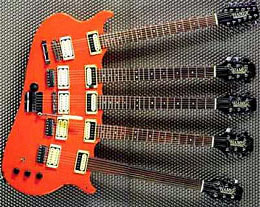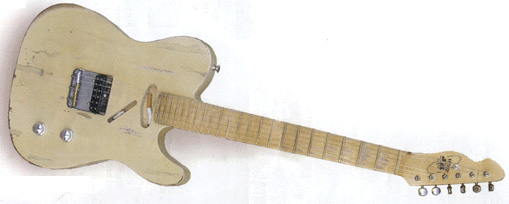Is There a Best Tone Weight?
Is heavier better or is lighter better?

Ask 100 guitar-slingers what guitar bodies are best for tone, and you’ll probably have around 50 say heavy and 50 say light. Put ’em in a room together and things might get a little heated.
I’ve heard people swear that more wood = more tone and sustain. I’ve heard people swear that lighter wood = more “open” tone, which they describe as better. I’ve read that the shape of the body makes a difference in tone. So it’s all different, but is one “better” than another?
Gibson.com recently published a piece about heavy vs. light (does Gibson have any light guitars?!) that starts of saying, “There’s a lot of hubbub out there about light guitars, to the extent that the lighter the guitar, the more desirable it is, so much so that weight is almost the main consideration for some.”
It continues: “There is often something to this, in that many guitars on the lighter side of average for their model do exhibit excellent resonance and musicality. On the other hand, an equal number of guitars on the heavier side of that bell curve also sound equally outstanding.”
A-ha!
Then the writer makes an interesting point, though I would take it maybe in a different direction. He says, “Aside from the fact that a lighter guitar might be more comfortable to play for extended periods of time…part of the preconception that lighter guitars sound better obviously comes from the fact that many guitars manufactured in the ‘golden era’ of the 1950s and early ’60s weighed less than the same models made in the late ’60s, ’70s and ’80s.”
He says this is because “Gibson and Fender were turning out their instruments in lower numbers in the early days, using readily available supplies of well-seasoned wood. As production rose from the hundreds to the tens of thousands, manufacturers needed to get what wood they could, which often meant the use of heavier, younger and less scrupulously selected timber.”
Interesting, particularly that “well-seasoned” part. That’s basically what happens to all guitars over time. Assuming they’re not covered with an inch-thick coat of polyester or polyurethane, guitars (bodies) will season themselves, meaning the wood will breathe, lose moisture, become lighter and may – MAY – acquire more tone.
Incidentally, this is why “nitro”-finished guitars (nitrocellulose lacquer) are more coveted by a lot of people. Yes, many now-vintage guitars nitro-finished, but nitro breathes, which means newer nito-finished (or similar, like oil-finished) guitars will breathe – and vintage nitro guitars have been breathing for decades.
EVH and BFG
Let’s take a couple of well-known slingers as examples: Edward Van Halen and Billy F. Gibbons.
EVH
- EVH’s “Frankie” guitar allegedly had a northern ash body, which meant it was heavy.
- But it was only finished in Schwinn bicycle paint, which meant it breathed.
- Since Frankie was slapped together in the late ’70s, that guitar has breathed for 30 years – and apparently the recent $25,000 replica Frankies all had lightweight bodies.
- Don’t for a minute think that Ed wouldn’t notice a change in tone, and seek to capitalize on it if he liked it: His new EVH Wolfgang guitars are unfinished in spots (I believe in the tremolo and electronics cavities) to capitalize on this breathing/aging process.
BFG
- Billy apparently has had lightweight clones made of all of his main guitars. And according to the recent ZZ Top DVD, at least one of the guitars has hollow spaces in the neck, possibly in part to compensate for a very light (chambered, hollow-out, whatever) body.
- It’s possible that Billy wanted lightweight guitars because he’s getting on in age, but one thing’s for sure: He’s not playing them if they don’t sound good.
- A member of the Telecaster forum by the name of newtwanger had this to say about BFG’s chambered Tele-like guitar: “I’ve got one if those chambered necks and can tell you it’s quite interesting-sounding. It weighs in about 4 ounces less than my lightest neck and noticeably amplifies the unplugged sound (you can feel the resonance in your left hand). Plugged in it’s not really noticeable since I play that guitar “dirty.” It’s really the only way to balance a 3-pound body and avoid a diving neck. The chambered body (2 pc ash, 1 pc ash top) and neck together come in at about 3 lbs., 13 oz.”

Here’s Billy’s super-light Tele-Pearly hybrid
So where does that leave us? Lighter is better? Or just older guitars sound better?
Wait a sec.
Do you like EVH’s Van Halen I sound or his 1984 sound better? Do you like BFG’s Fandango sound or his Rhythmeen sound better?
Uh-huh. I thought so. Which brings us to…
The Conclusion (sorta)
Back to the Gibson.com article: “Wood is an organic material, and therefore somewhat intangible in its raw form, and often there’s no telling a good piece of tone wood from a poor one until you have cut and routed it and made it into a guitar. That said — and all else being equal (which, of course, it never is) — lighter [older?] guitars will tend to sound more open, percussive, and somewhat scooped in the mids, with more bell-like highs. Heavier [newer?] guitars will tend to have a thicker midrange, chunkier lows and more eviscerating highs.”
Here’s what I can say about it from experience:
- I’ve got two Les Pauls that weigh noticeably more than my Strat and Tele, but so what? They sound awesome – though I now am thinking about sanding off some finish to let them breathe….
- I had a super strat made in the late ’80s, with an alder body. Because of humid weather and my impatience, the body was never finished properly – the finish quickly cracked, or “scaled,” and the wood breathed. It has always sounded good, and is neither light nor heavy (note that “light” and “heavy” are relative).
I think the bottom line is that we all know you can line up 10 Les Pauls and 10 Strats and 10 Teles – all the same year, model, wood, hardware, pickups and strings, all through the same amp – and they’ll all sound different. So what does that tell you?
For me, even with a temperamental back, I could care less if a guitar is light or heavy. If it sounds good and feels good, it is good. You’re probably in the same boat.
Category: Billy Gibbons, Edward Van Halen, Guitar woods














Excellent perspective! I had the opportunity to try a homemade More Paul= basically a 5 pickup Les tapped for coil& phase (thus about 84 tone configs) as thick as a a Les with an SG glued to the back. heavy? Uh-huh. Toney? Nay so much. But super lite planks sound like tennis racquets. So there seems to be an optimum mass range between Strats and aged/or chambered Les for standard tuning. (But chunkier works better for substandard tunings.)
And of course, lots of debating to be done!!